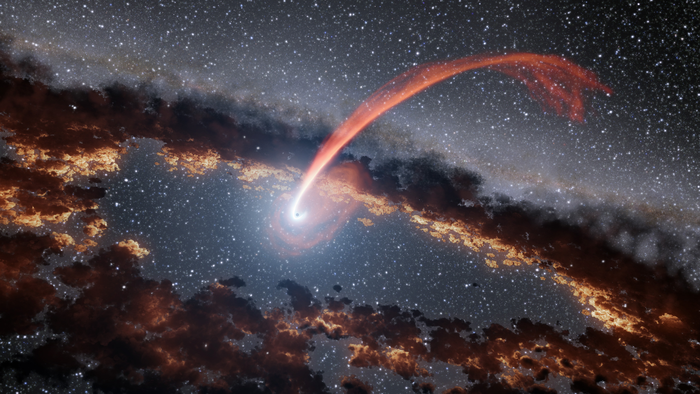This is what it looks like when a black hole snacks on a star
While black holes and toddlers don’t seem to have much in common, they are remarkably similar in one aspect: Both are messy eaters.

[Sept 28, 2021: University of Arizona]
This illustration shows a glowing stream of material from a star, torn to shreds as it was being devoured by a supermassive black hole. The feeding black hole is surrounded by a ring of dust, not unlike the plate of a toddler is surrounded by crumbs after a meal. (Credit: NASA/JPL-Caltech)
While black holes and toddlers don't seem to have much in common, they are remarkably similar in one aspect: Both are messy eaters, generating ample evidence that a meal has taken place.
But whereas one might leave behind droppings of pasta or splatters of yogurt, the other creates an aftermath of mind-boggling proportions. When a black hole gobbles up a star, it produces what astronomers call a "tidal disruption event." The shredding of the hapless star is accompanied by an outburst of radiation that can outshine the combined light of every star in the black hole's host galaxy for months, even years.
In a paper published in The Astrophysical Journal, a team of astronomers led by Sixiang Wen, a postdoctoral research associate at the University of Arizona Steward Observatory, use the X-rays emitted by a tidal disruption event known as J2150 to make the first measurements of both the black hole's mass and spin. This black hole is of a particular type – an intermediate-mass black hole – which has long eluded observation.
"The fact that we were able to catch this black hole while it was devouring a star offers a remarkable opportunity to observe what otherwise would be invisible," said Ann Zabludoff, UArizona professor of astronomy and co-author on the paper. "Not only that, by analyzing the flare we were able to better understand this elusive category of black holes, which may well account for the majority of black holes in the centers of galaxies."
By re-analyzing the X-ray data used to observe the J2150 flare, and comparing it with sophisticated theoretical models, the authors showed that this flare did indeed originate from an encounter between an unlucky star and an intermediate-mass black hole. The intermediate black hole in question is of particularly low mass – for a black hole, that is – weighing in at roughly 10,000 times the mass of the sun.
"The X-ray emissions from the inner disk formed by the debris of the dead star made it possible for us to infer the mass and spin of this black hole and classify it as an intermediate black hole," Wen said.
Dozens of tidal disruption events have been seen in the centers of large galaxies hosting supermassive black holes, and a handful have also been observed in the centers of small galaxies that might contain intermediate black holes. However, past data has never been detailed enough to prove that an individual tidal disruption flare was powered by an intermediate black hole.
"Thanks to modern astronomical observations, we know that the centers of almost all galaxies that are similar to or larger in size than our Milky Way host central supermassive black holes," said study co-author Nicholas Stone, a senior lecturer at Hebrew University in Jerusalem. "These behemoths range in size from 1 million to 10 billion times the mass of our sun, and they become powerful sources of electromagnetic radiation when too much interstellar gas falls into their vicinity."
The mass of these black holes correlates closely with the total mass of their host galaxies; the largest galaxies host the largest supermassive black holes.
"We still know very little about the existence of black holes in the centers of galaxies smaller than the Milky Way," said co-author Peter Jonker of Radboud University and SRON Netherlands Institute for Space Research, both in the Netherlands. "Due to observational limitations, it is challenging to discover central black holes much smaller than 1 million solar masses."
Despite their presumed abundance, the origins of supermassive black holes remain unknown, and many different theories currently vie to explain them, according to Jonker. Intermediate-mass black holes could be the seeds from which supermassive black holes grow.
"Therefore, if we get a better handle of how many bona fide intermediate black holes are out there, it can help determine which theories of supermassive black hole formation are correct," he said.
Even more exciting, according to Zabludoff, is the measurement of J2150's spin that the group was able to obtain. The spin measurement holds clues as to how black holes grow, and possibly to particle physics.
This black hole has a fast spin, but not the fastest possible spin, Zabludoff explained, begging the question of how the black hole ends up with a spin in this range.
"It's possible that the black hole formed that way and hasn't changed much since, or that two intermediate-mass black holes merged recently to form this one," she said. "We do know that the spin we measured excludes scenarios where the black hole grows over a long time from steadily eating gas or from many quick gas snacks that arrive from random directions."
In addition, the spin measurement allows astrophysicists to test hypotheses about the nature of dark matter, which is thought to make up most of the matter in the universe. Dark matter may consist of unknown elementary particles not yet seen in laboratory experiments. Among the candidates are hypothetical particles known as ultralight bosons, Stone explained.
"If those particles exist and have masses in a certain range, they will prevent an intermediate-mass black hole from having a fast spin," he said. "Yet J2150’s black hole is spinning fast. So, our spin measurement rules out a broad class of ultralight boson theories, showcasing the value of black holes as extraterrestrial laboratories for particle physics."
In the future, new observations of tidal disruption flares might let astronomers fill in the gaps in the black hole mass distribution, the authors hope.
"If it turns out that most dwarf galaxies contain intermediate-mass black holes, then they will dominate the rate of stellar tidal disruption," Stone said. "By fitting the X-ray emission from these flares to theoretical models, we can conduct a census of the intermediate-mass black hole population in the universe," Wen added.
To do that, however, more tidal disruption events have to be observed. That's why astronomers hold high hopes for new telescopes coming online soon, both on Earth and in space, including the Vera C. Rubin Observatory, also known as the Legacy Survey of Space and Time, or LSST, which is expected to discover thousands of tidal disruption events per year.
For more science stories check out our New Discoveries section at The Brighter Side of News.
Like these kind of feel good stories? Get the Brighter Side of News' newsletter.
Tags: #New_Discoveries, #Black_Holes, #Stars, #Space, #Science, #Astronomy, #Research, #The_Brighter_Side_of_News
Joshua Shavit
Science & Technology Writer | AI and Robotics Reporter
Joshua Shavit is a Los Angeles-based science and technology writer with a passion for exploring the breakthroughs shaping the future. As a contributor to The Brighter Side of News, he focuses on positive and transformative advancements in AI, technology, physics, engineering, robotics and space science. Joshua is currently working towards a Bachelor of Science in Business Administration at the University of California, Berkeley. He combines his academic background with a talent for storytelling, making complex scientific discoveries engaging and accessible. His work highlights the innovators behind the ideas, bringing readers closer to the people driving progress.



